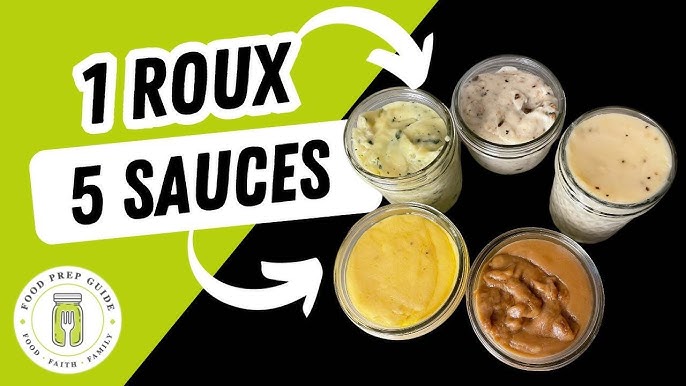Roux Recipe: Roux is one of the fundamental building blocks of cooking, especially in French and Creole cuisines. It’s a simple mixture of fat and flour cooked together, used primarily to thicken sauces, soups, and gravies. Whether you’re preparing a creamy béchamel sauce, a rich gumbo, or a velvety gravy, roux is the secret ingredient that brings everything together.
What is Roux?
At its core, roux is a paste made by cooking equal parts of fat (such as butter, oil, or lard) and flour. The flour is cooked to eliminate its raw taste, while the fat helps distribute the flour evenly, preventing lumps when liquids are added.
Importance of Roux in Cooking
- Thickener: It gives sauces and soups the desired consistency.
- Flavor Enhancer: Roux adds a nutty, toasted flavor when cooked longer.
- Versatility: Different types of roux suit various dishes, making it adaptable for any recipe.
- Color and Texture: It provides rich color and smooth texture to gravies and stews.
Types of Roux
There are three main types of roux, each with its unique flavor and color profile. The type you choose depends on the recipe and the flavor you want to achieve.
1. White Roux
- Appearance: Pale and creamy in color.
- Cooking Time: 2-3 minutes.
- Best For: Béchamel sauce, creamy soups, and gravies.
- Flavor: Mild with little to no toasted flavor.
2. Blonde Roux
- Appearance: Light golden-brown.
- Cooking Time: 5-7 minutes.
- Best For: Velouté sauces and chicken stews.
- Flavor: Slightly nutty and richer than white roux.
3. Brown Roux
- Appearance: Deep brown color.
- Cooking Time: 10-20 minutes.
- Best For: Gumbo, étouffée, and Cajun dishes.
- Flavor: Rich, toasty, and earthy.
Ingredients Required for Roux
Essential Ingredients
- Fat: Butter, vegetable oil, or lard.
- Flour: All-purpose flour is most commonly used.
Optional Ingredients for Flavor
- Seasonings: Garlic powder, onion powder, or paprika.
- Spices: Cayenne pepper for heat or nutmeg for a subtle aroma.
- Broth/Stock: Sometimes added to enhance depth.
Tools Needed to Make Roux
Cooking Utensils
- Heavy-Bottomed Pan or Skillet: Prevents burning and ensures even heat distribution.
- Wooden Spoon or Silicone Spatula: Ideal for stirring without scratching the pan.
Measuring Tools
- Measuring Cups: To ensure equal parts fat and flour.
- Whisk: Helps achieve smooth consistency when liquid is added.
Step-by-Step Guide to Making Roux
Step 1: Preparing Ingredients
- Measure equal parts fat and flour. For example:
- 1/4 cup butter + 1/4 cup flour = 1/2 cup roux.
- Preheat your pan over medium heat.
Step 2: Cooking Process
- Melt the fat in the pan, ensuring it doesn’t burn.
- Gradually add the flour while stirring continuously.
- Cook the mixture while stirring until it reaches the desired color:
- White Roux: Stop after 2-3 minutes.
- Blonde Roux: Continue for 5-7 minutes.
- Brown Roux: Stir for 10-20 minutes for a deeper color.
Step 3: Achieving the Desired Color
- Keep an eye on the color change as it indicates the flavor profile.
- Use low heat for more control to avoid burning.
- Stir consistently to prevent lumps and uneven cooking.
Tips for Perfect Roux
- Constant Stirring: Prevents lumps and ensures smooth consistency.
- Low Heat: Slower cooking gives better control and flavor.
- Patience is Key: Don’t rush the process, especially for brown roux.
- Taste Testing: Sample as you go to monitor flavor development.
Common Mistakes to Avoid
- Overcooking: A burnt roux tastes bitter and ruins the dish.
- Using Cold Liquid: Always add warm or hot liquid to the roux to prevent clumping.
- Skipping Stirring: Leads to uneven cooking and lumps.
How to Store Roux Properly
Proper storage of roux ensures that you can prepare it in advance and use it whenever needed, saving time during cooking. Here’s how to store roux effectively:
Storing in the Refrigerator
- Cooling First: Allow the roux to cool completely before transferring it to a container.
- Airtight Container: Store it in a glass jar or airtight plastic container to prevent moisture contamination.
- Shelf Life: Roux can last up to 2 weeks in the refrigerator if stored properly.
- Reheating: Warm it in a skillet over low heat before adding it to recipes to restore its consistency.
Freezing Roux for Long-Term Use
- Freezer-Safe Containers: Use ice cube trays or small freezer bags for portioned storage.
- Label and Date: Mark each portion with the date for easy tracking.
- Shelf Life in Freezer: Roux can last up to 6 months when frozen.
- Thawing: Defrost in the refrigerator overnight or heat directly in a pan if frozen in small cubes.
Uses of Roux in Cooking
Roux is incredibly versatile and serves as the base for many dishes. Here’s how it’s commonly used:
Base for Sauces
- Béchamel Sauce (White Sauce): A creamy foundation for lasagna, macaroni, and cheese.
- Velouté Sauce: A light, savory sauce ideal for chicken and seafood dishes.
- Gravy: Perfect for holiday turkey or mashed potatoes.
Thickener for Soups and Stews
- Gumbo and Cajun Dishes: Brown roux gives depth and flavor to Southern recipes.
- Creamy Soups: Roux thickens broccoli cheddar soup, potato soup, and chowders.
- Stews and Casseroles: Adds body and smoothness to hearty dishes.
Savory Pies and Pot Pies
- Roux thickens fillings for chicken pot pie, beef pies, and vegetable bakes, ensuring a rich consistency.
Roux Variations and Substitutes
Roux can be adapted to fit different dietary needs without compromising flavor.
Gluten-Free Roux
- Alternative Flours: Use rice flour, cornstarch, or gluten-free all-purpose flour.
- Cooking Method: Follow the same steps, but monitor closely as gluten-free flours may cook faster.
Dairy-Free Roux Options
- Fat Alternatives: Replace butter with olive oil, coconut oil, or vegan butter.
- Flavor Enhancers: Add garlic or onion powder to make up for the lack of buttery richness.
Pairing Roux with Recipes
Best Recipes for White Roux
- Creamy Alfredo Pasta
- Béchamel-Based Lasagna
- Cheese Sauce for Mac and Cheese
Ideal Dishes for Brown Roux
- Cajun Gumbo
- Jambalaya
- Beef Stews
Blonde Roux Favorites
- Chicken Gravy
- Vegetable Soups
- Velouté Sauces
Troubleshooting Roux Problems
Fixing a Burnt Roux
- Solution: Unfortunately, burnt roux cannot be salvaged. It’s best to start over and monitor the heat closely.
Correcting a Runny Roux
- Solution: If the roux is too thin, cook it a little longer to evaporate excess moisture or add a pinch more flour.
Dealing with Clumps
- Solution: Whisk vigorously or blend the mixture for smooth consistency before use.
Expert Tips for Professional Roux
- Patience is Key: Good roux takes time, especially for darker versions. Slow cooking prevents burning and enhances flavor.
- Flavor Boosters: Add spices or herbs during cooking for extra aroma and taste.
- Use Quality Ingredients: High-quality butter and flour make a noticeable difference in flavor.
- Pre-Portion and Freeze: Freeze small portions to save time when cooking larger meals.
- Experiment with Oils: Try different fats like bacon grease or duck fat for unique flavors.
FAQs about Roux Recipe
What is a roux?
A roux is a thickening agent made from equal parts of flour and fat, cooked together, and used to thicken sauces, soups, and gravies. It’s a foundational element in many cuisines, particularly French and Creole cooking.
How do you make a roux?
To make a roux, start by melting the fat (butter is most commonly used) in a pan over medium heat. Add an equal amount of flour and stir continuously to combine the ingredients into a smooth paste. Cook the mixture for a few minutes until it reaches the desired color and nuttiness—be it blonde, brown, or dark—depending on its intended use.
What types of fat can be used in a roux?
While butter is traditional, other fats like oil, bacon grease, or lard can also be used. The choice of fat often depends on the recipe and the desired flavor profile.
How long does it take to cook a roux?
The cooking time for a roux can vary. A blonde roux may take about 5 minutes, whereas a darker roux, like those used in Cajun and Creole cooking, might cook for 20 to 30 minutes to develop a deep, rich flavor.
Can you make roux in advance?
Yes, roux can be made ahead of time and stored in the refrigerator for up to a week or frozen for several months. This can be a great time-saver when preparing meals that require a thickening agent.
What is the ratio of flour to fat in a roux?
The standard ratio for a roux is 1:1 by weight of flour to fat. This ratio ensures that the roux has enough fat to cook the flour without it clumping, achieving a smooth consistency.
Is roux gluten-free?
Traditional roux is not gluten-free as it uses wheat flour. However, gluten-free flours such as rice flour or chickpea flour can be used as substitutes to make a gluten-free roux.
How do you know when a roux is done?
The roux is done when it has reached the desired color and emits a nutty aroma. It’s important not to rush this process, as the flavor and color of the roux significantly impact the dishes it enriches.
Conclusion
Mastering the art of making roux is an essential skill that can elevate your cooking to the next level. Whether you’re whipping up a creamy sauce, a rich gravy, or a hearty gumbo, knowing how to prepare and use roux ensures delicious results every time. With proper storage and a few expert tips, you’ll always have this versatile base ready to add flavor, texture, and depth to your recipes.



